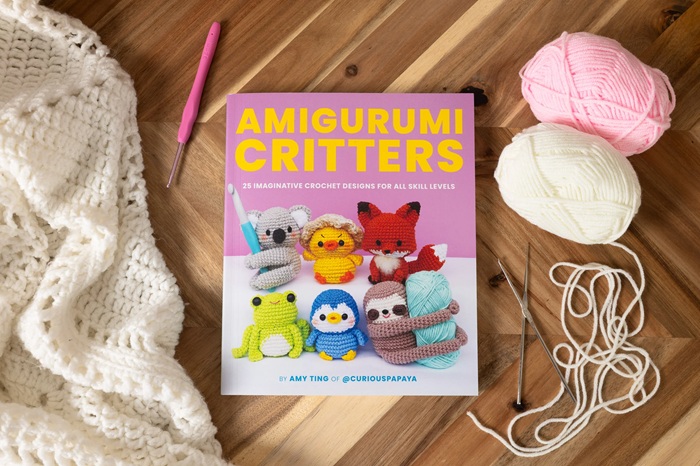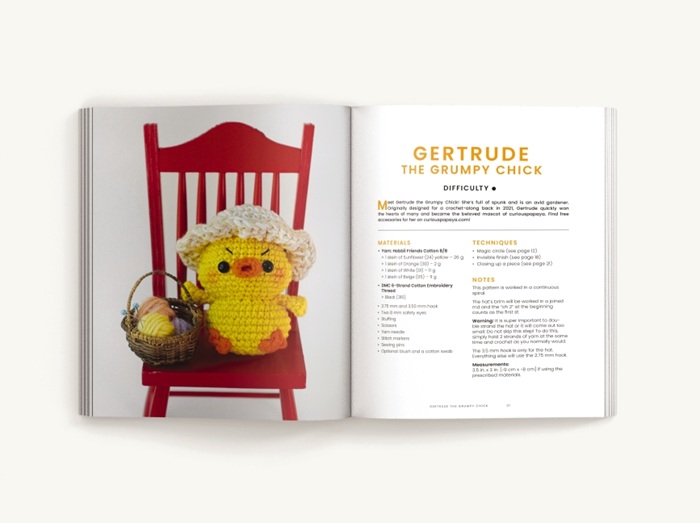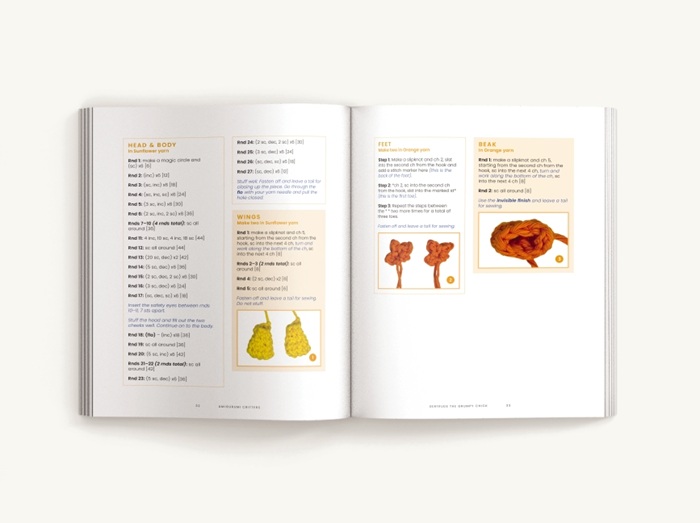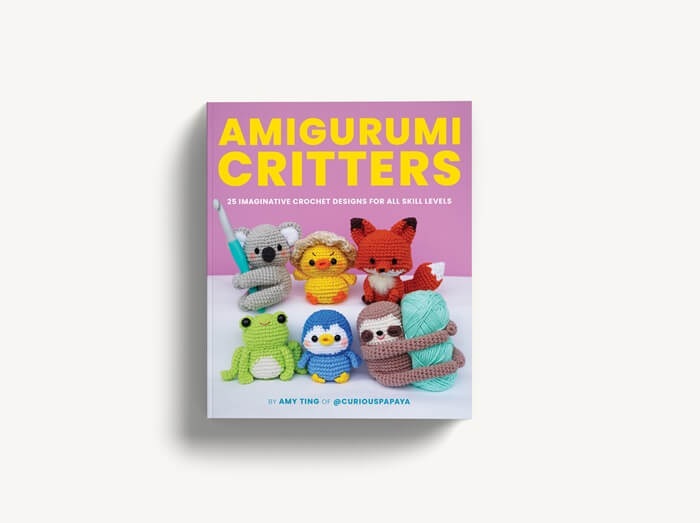
Learn all about Amy Ting of Curious Papaya in our interview! In her new book, Amigurumi Critters, she offers step-by-step guidance along with 25 unique amigurumi designs suitable for all skill levels but especially ideal for those looking to challenge themselves and grow their crocheting skills.
Learn more and get your copy here: Amigurumi Critters.
How long have you been crocheting, and how has your relationship with the craft changed over time?
I first picked up a hook in 2018 (so that makes it 7 years now – hard to believe)! Initially, it was meant to be a hobby I could look forward to to destress after work. Little did I know, it would soon become my lifelong passion and full-time business!
What drew you to amigurumi specifically?
Characters from Sanrio and Pokémon shaped my childhood and it looks like I never outgrew my love for them. I dabbled in all sorts of crafts before landing on crochet. The idea of being able to make my own plushies was enough to captivate me. Once I started, I never stopped.
Were there any early challenges you faced when learning to crochet, especially in 3D? How did you overcome them?
It’s crazy to see how much more accessible resources to learn are nowadays. They were a lot more limited just 7 years ago! I learned from watching blurry Youtube tutorials and by playing them at 0.25x speed, full screen.
Some BIG mistakes I made in the beginning included: confusing UK and US terminology, picking out whatever yarn and hook based on the color (totally ignoring the “weights”), and not understanding how changing up the prescribed materials would drastically change the outcome.
One of my very first projects was an amigurumi carrot – which turned out humungous! I laugh at how I was in complete doubt for the entire project but just kept telling myself to “trust the process”. Yep, I ended up with a holey carrot the length of my arm.

What inspired you to start designing your own patterns rather than just following others?
Simply put, I just love love love to create. The tactileness. The creative freedom. Satisfying that itch in my brain to pour in 110% of myself into honing a new skill. As I began to understand how sculpting with yarn worked, creating my own designs was the only natural course to follow. I truly love the challenge of turning a vision into a tangible creation. I still really enjoy following other designers’ patterns – there’s always something new to learn.

What does your design process look like from idea to finished pattern?
I’d like to say that I have the system down pat but the truth is, it really differs! In most cases, I “build the plane as I fly it” – going directly from my mind to my hook. In other cases, I need to sketch things out, troubleshoot parts I want to improve, and make prototype after prototype. At the very minimum, it might take me ~5 hours to craft a pattern from start to finish (minus all of the editing, photography, formatting, listing… er… the list goes on). At the very most, a pattern could take me weeks.
Do you have a favorite type of character or creature you love designing most? Why?
It would certainly be a tie between two of my favorite things in life – animals and food! I find animals so fascinating and they just make me appreciate how beautiful life is. As for food, it’s a huge part of any culture which is why it’s such a crowd favorite. I do have some fun designs of burgers, hotdogs, and such – but my true passion lies within creating foods that celebrate my Taiwanese and Korean heritage.
What inspired you to write Amigurumi Critters?
Settling on the theme of animals is actually something my editor Amanda and I did together. The initial proposal my publisher had was a myriad of miscellaneous, easy makes – however, I just didn’t feel entirely connected to it. Though it would have been fun, I really wanted my first big book to be something that would challenge me as a designer as well as allowing for more complex skills to be used. I’m beyond grateful that Amanda saw my potential and trusted me enough to have as much creative freedom as I wanted. That’s really what allowed my best work to come forward.
How did you decide which patterns to include in the book? Were they created just for the book, or drawn from your past work?
Oh, that was so hard! I began brainstorming by typing out a super long list of the most popular animals and narrowing it down from there. Some factors I took into consideration were: including a good variety of critters (land vs. aquatic) and balancing the complexity levels of each design. I was able to use some of my existing patterns (such as my sea otters and frog) but the majority of the book is made up of new designs that are exclusive to it.
Was there a theme or message you wanted to convey through this collection?
Hmm. Does the theme of “adorable cuteness” count?! In all seriousness, I really wanted crafters of all levels to be able to enjoy this collection of patterns and for there to be something for everyone. Because I wanted to make it as accessible as possible, I spent a great deal creating the tips/techniques section of the book as well as video tutorials for some of the more intermediate skills.
Did you face any unexpected challenges during the book-making process—creative, technical, or otherwise?
Absolutely, yes! I don’t think the challenges designers go through are discussed enough. It was not only my first time publishing a crochet book but also my publisher’s. Because of that, there were a lot of things to discover together.
As for the designs, the trickiest animals that required the most revisions were the ocean animals (like the shark and dolphin). In general, their bodies are elongated and when you’re working in a continuous spiral, you have to account for the inevitable rotation of the start of the round.
As for the technical challenges, stepping up my photography game was where I experienced the steepest learning curve. I’ve only ever used my phone camera to photograph and edit my content – which was perfectly fine for social media!
I had to learn a lot and adjust to the editor’s feedback when capturing content for printed media – something that was completely new to me. Communication was key in helping us to overcome those challenges.
Which pattern in the book holds the most meaning for you personally, and why?
Finnegan the Fox. I remember the day I sent my confirmation email to my editor and when “Amigurumi Critters” was official. I was on cloud nine and was riding a massive creative wave so I got to work right away. Finnegan’s design was one of the ones that went directly from my mind to my hook (as I mentioned earlier). In fact… it felt like my mind was moving far too fast for my hands to keep up, and having to deal with the slow nature of this craft was quite frustrating, ha! (Maybe this is a total ADHD thing.) I couldn’t wait to bring him to life. I’ll never forget the feeling and significance in creating him.
Have you noticed any trends in amigurumi lately that excite you—or any you hope make a comeback?
From my own observations, trending amigurumi topics include: Chenille yarn, no-sew patterns (for chenille yarn in particular since it really mitigates the issue with the yarn shedding), bag charms (think Jellycat, Labubus, and other collectible charms), and the use of glittery sinker eyes (glass safety eyes that create a different look from traditional, simple black safety eyes).
Do you have future projects or goals you’re excited about—another book, a new series, collaborations?
Of course, I’m looking forward to starting my next crochet book! Those things can’t be rushed though and I firmly believe that the right opportunity will come as I continue to grow and do what I love. In the meantime, I’m preparing for a huge craft market! It’ll be a two day holiday craft fair here in the heart of San Jose, California. I’m planning on going BIG with creating a “grocery market” theme and I can’t wait to see it all come together.
What do you hope readers and makers take away from your book, beyond the finished toys themselves?
JOY! And that creating is our lifeblood and helps us to see the world in color.
—
We hope you loved this interview with Amy Ting! Learn more and get your copy of her new book here: Amigurumi Critters.



